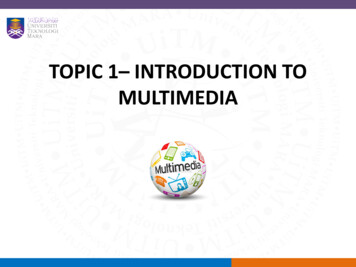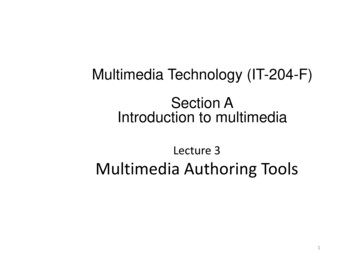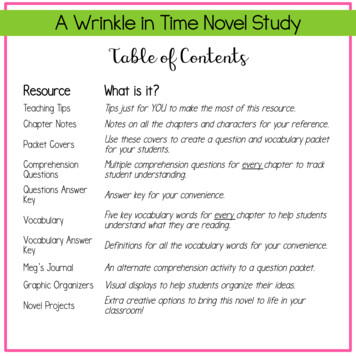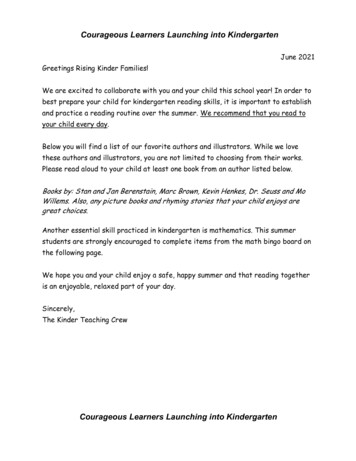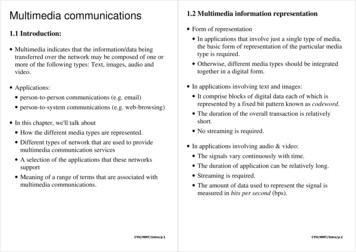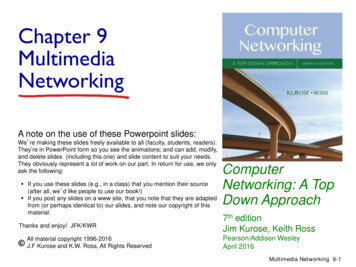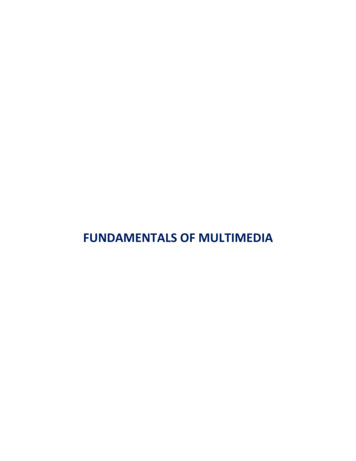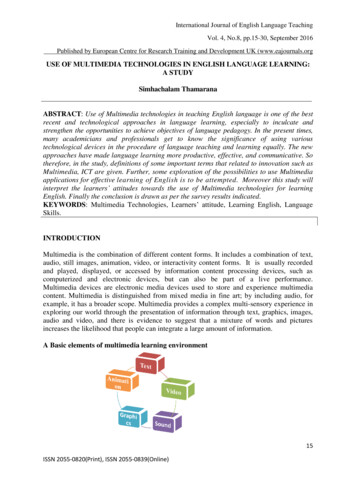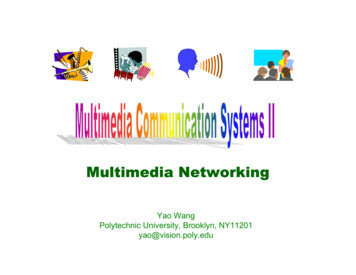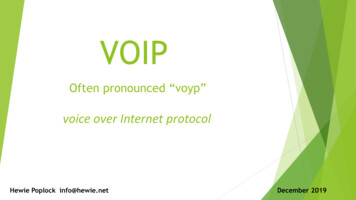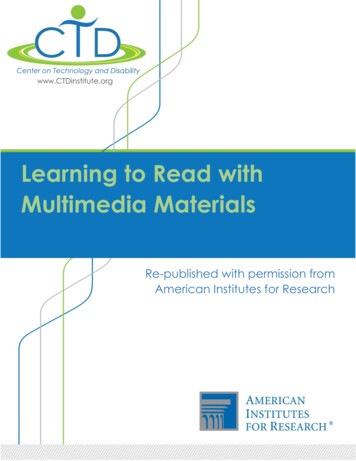
Transcription
Learning to Read withMultimedia MaterialsRe-published with permission fromAmerican Institutes for Research
Learning to Read with Multimedia MaterialsBy: Center for Technology Implementation in Education(CITEd)The National Reading Panel (2000) identified three key elements of effective readinginstruction: alphabetics (phonemic awareness and phonics), fluency, andcomprehension (vocabulary, text comprehension, and comprehension strategies).After evaluating the research base for each element, the panel determined thatinstructional attention to these elements is critical to the development of independent,motivated readers. Unfortunately, many students struggle with reading, and readingachievement remains a serious concern among educators and parents.Technology and multimedia materials offer the potential for addressing the challengesof reading instruction. For more than 2 decades, researchers have been usinginnovative technology to engage students, build connections between oral andwritten language, prompt active reading, and provide supplemental tutoring. In theprocess, technology and the understanding of how to support reading instruction andachievement have both advanced.Some educators and parents express concern that if digital texts are used too early inthe process of learning to read, students may never become strong, competent,independent readers of print. However, there is a steadily growing body of researchshowing that digital text and multimedia environments can play a powerful supportingrole in reading instruction.Multimedia reading materials and environments offer a variety of flexible supportsincluding text-to-speech, voice recognition, animation, music and sound effects,embedded dictionaries, linked videos to boost background knowledge andvocabulary, study tools such as highlighters and annotation capabilities, andanimated agent tutors. They have the capacity to support choice of content andtools, adjustable challenge level, and adjustable practice and feedback. ThisResearch in Brief article considers the research on the potential of multimediamaterials and environments to support reading for struggling readers. We offersuggestions for choosing multimedia materials and integrating them into readinginstruction effectively. The article includes four main sections: an overview of theresearch implications for integrating multimedia materials into reading instruction,
advice for choosing multimedia materials for reading instruction, a list of the resourcescited in the article, and a more detailed description of the research literature.Overview of Using Multimedia to Support Reading InstructionIn this first section, we offer suggestions based on the research for integratingmultimedia materials and environments into reading instruction. The section isstructured according to five key areas of reading research.Phonemic AwarenessThe goal of phonemic awareness instruction is to build students’ awareness of thephonological structure—sound--of language and to help them understand thatphonological elements can be manipulated. Young students, students new to English,and students of any age who are emerging readers need to have a firm grasp of therelationship between oral and written language. For many children, this awarenessgrows naturally through word play; for students with learning English or difficulties, itrarely grows without explicit instruction.Teachers are always looking for ways to make instruction exciting for students; so aremultimedia designers. For more than a decade, various multimedia programs havebeen used to teach phonemic awareness, and such programs have shown consistentpromise, boosting users’ phonemic awareness. Because they are able to animate therelationships between oral language and print, the concepts are less abstract.Students with poor phonemic awareness need to practice and improve thisfundamental skill. Conversely, students who have strong phonemic awareness mostlikely do not need additional practice. Therefore, individualized instruction is important.Educators are wise to select commercial software and web-based programs that offerindividualized learning paths and/or progress monitoring.Many commercial programs and free Web-based programs offer practice inphonemic awareness and other basic skills that draw attention to the features of printand language, reinforce classroom instruction, and increase engagement with print.Television and video programs that teach print concepts through multimedia are alsoengaging and reinforce rhyme and language play. For example, the award-winningPBS show, Between the Lions, supports emergent reading through activities, songs, andstories (discussed below in Research Support).Multimedia programs should be considered a supplement to quality, explicitinstruction. To promote transfer, the concepts in these programs should be reinforced
during instruction by, for example, adopting the terms the program uses and revisitingsample words from the program. Programs that focus centrally on print and languageconcepts (rather than bury these elements in other distracting elements) andprograms that include progress monitoring features are best.Phonics and Word RecognitionEmergent readers need to understand how the written language works, that is, thephonics rules and underlying orthography that are unique to English. Multimediamodels of these relationships and rules can make them more comprehensible andconcrete. Computer-based multimedia, video, and television programs have beeninvestigated for their effectiveness in providing opportunities to experience languagein an engaging, fun, and memorable way. Computer-based activities that animatethe creation and manipulation of words, such as the programs described in theprevious section, have been shown to improve students’ word recognition (discussedbelow in Research Support). Thus, computer- or video-based activities are a goodoption to consider for providing students with targeted supplemental instruction andadditional demonstrations and practice.FluencyFluency is key to reading competence, enabling readers to devote their cognitiveeffort to comprehension and enjoyment of reading. For struggling readers whodecode laboriously or ignore punctuation and natural phrasing, fluency instructionand practice are necessary and effective (Kuhn & Stahl, 2003). There are twoimportant approaches to improving fluency: engagement with print (i.e., plentifulreading) and repeated reading (Meyer & Felton, 1999). By reading a familiar textaloud multiple times, students can begin to coordinate their decoding, semantic, andsyntactic skills.Students need to read engaging material silently and aloud and with ready supportfor words and concepts that they do not know. Researchers have investigated theeffectiveness of providing fluency support in the form of multimedia environments thatcombine text-to-speech and speech recognition to listen to students’ reading andprovide targeted and differentiated feedback and guidance. These programs canfunction as an electronic tutor; some are designed with an animated agent thatinteracts with the student like a tutor. These programs have been found to be helpfulto students and their instructors, providing students with needed word recognition andfluency support and parents and educators with progress monitoring informationneeded to tailor instruction. Given the limited supply of trained reading tutors and
specialists who can provide a fluent oral model and one-on-one tutoring, theeffectiveness of e-tutors is encouraging. Educators should look for multimedia readingprograms that provide supported practice. Online demonstrations of two e-tutors(discussed below in Research Support) are available: The Reading Tutor in ProjectLISTEN and Scientific Learning.Comprehension StrategiesComprehension is the ultimate goal of reading, yet it is notoriously difficult to instruct.Multimedia environments can mirror and reinforce proven teacher-led strategyinstruction through the use of pop-ups, linked questions, online resources, andanimated reading coaches or e-tutors that engage in questioning, prompts, and thinkalouds.Struggling readers’ comprehension is often impaired by a limited reading vocabulary.Increasing vocabulary is an important goal and necessary component ofcomprehension. Multimedia texts with supports for vocabulary development, such aslinked mini-videos demonstrating a concept or dictionaries and thesauruses with textto-speech capabilities, can help students achieve this goal and improvecomprehension.Getting students to use supports effectively is a significant instructional challenge.Studies consistently show that students–especially those who are struggling–needprompting in order to access supports when they need them. Accessing appropriatesupports is a skill and habit to be taught and learned. This can be accomplishedthrough explicit instruction with a whole- or small- group activity. Students need to beprompted to regularly use supports while they are working, either through verbalreminders or study guides that accompany the reading assignment.When strategy prompts and supports are embedded in the text, they are more timelyand targeted for readers. These kinds of supports are just becoming commerciallyavailable. Two examples (discussed below in Research Support) are: iSTART andThinking Reader , developed by Tom Snyder Productions, Scholastic.Watch for new projects and products that prompt students to access supports, applystrategies, and stop to monitor their comprehension.EngagementInterest and engagement should be considered a significant outcome in literacyinstruction and research as they are “a powerful determinant of the effectiveness of
any given literacy approach” (Strangman and Dalton, 2005, p. 559) and vital “tostudents’ evolving feelings about reading itself” (p. 560).Choice is key. Teachers can help students find motivating material among the growingselection of digital text available on the Web--for purchase or through subscriptionsites for students with diagnosed disabilities. Some Web-based sites embed supportsinto their selections. By importing text lacking embedded supports into readingprograms, educators can leverage the multimedia supports with an increasing array oftext.Choosing a ProgramNo one program or approach will meet the needs of all students, so to engagestudents in their own learning it is wise to try a variety of interventions andsupplemental activities and consult students in the process. Programs that arecustomizable and have a variety of digital texts will best meet diverse needs andinterests. To promote transfer of learning, we recommend that educators look forprograms that support the instructional strategies and goals already addressed in theclassroom. Beware of programs that bury the elements of instruction in distractinganimation or story lines. See the TechMatrix for reviews of commercial and Web-basedreading programs and products.Research SupportPhonemic AwarenessFor over a decade, researchers have investigated the effectiveness of multimediacomputer-based programs for teaching and reinforcing phonemic awareness.Programs that provide emergent readers with visual and auditory examples of soundmanipulation (i.e., say star without the s sound) can make these concepts much lessabstract and help readers build connections between oral and written language.Computer-based practice with these concepts has been shown to increase strugglingstudents’ mastery of them (Baker & Torgeson, 1995; Heimann, Nelson, Tjus, & Gillberg,1995; Mitchell and Fox, 2001).Olson and Wise (2004) reflected on their decade-long investigation of computerbased remediation of phonemic awareness deficits in Colorado schools. They havedeveloped and tested two programs that serve as facilitated supplements toclassroom instruction, Accurate Reading in Context (ARC), where students spend 22hours reading stories with speech recognition, and Phonological Analysis (PA), whichprovides explicit instruction of speech articulation in addition to animated storybooks
and other word-level analysis. These facilitated supplemental interventions require atrained teacher or instructional aide to prompt and monitor young students’interaction with the computer-based program and to deliver small-group instructionsupportive of transfer. In a large study of elementary school students that includedmatched control groups, students who participated in the program demonstratedsignificant gains in phonemic awareness, decoding, and word reading which weremaintained at a 1- and 2-year follow-up (Wise, Ring, Olson, 2000). Both programsproduced similar results, suggesting that increased facilitated time spent reading–notthe specific type of training–was key. They suggest that additional time and transferactivities would increase performance and retention of gains.Phonics and Word RecognitionWise, Ring and Olson (2000) found that students’ word recognition significantlyimproved following facilitated supplemental training with their two programs (seeprevious section), which provided computer-based activities and small-groupinstruction. Lewandowski, Begeny, and Rogers (2006) found that 66 third-gradestudents’ word recognition, reading speed, and accuracy scores improved similarlyfollowing practice with a very simple (no graphics or animation) computer-basedreading program and work with a live tutor. Students’ scores in a no-help condition didnot improve. This study reinforces an earlier study in which Lewandowski and Montali(1996) showed that struggling elementary readers could perform as well as averageachieving peers on word recognition and accuracy tests when provided audio plusvisual input with computer-based practice.Television or video segments offer another potential means to make early readinginstruction comprehensible to young children. The Success for All program is astructured, research-based curriculum and school reform model. The programintroduced a multimedia component to their standard one-on-one tutoringcurriculum, which includes puppet routines and video segments intended todemonstrate reading concepts such as sound blending and segmentation. Onehundred and eight-nine students who received tutoring embedded with multimediacomponents achieved higher reading performance than students who were tutoredwithout the multimedia components (Chambers, Cheung, Madden, Slavin, & Gifford,2006). The authors note that the secondary goal of creating these multimediamaterials was to meet the ongoing need to provide professional development andmodels of tutoring instruction for the reading tutors.
Similarly, the PBS show Between the Lions, which demonstrates reading and languageconcepts in entertaining skits combined with animated text, has been studied as asupplement to regular school instruction. Linebarger, Kosanic, Greenwood, and Doku(2004) studied the impact of the program on 164 kindergarten and first-grade studentswho were at risk, at moderate risk, or not at risk for reading failure. Although allchildren’s print concepts and reading skills developed over the course of theinvestigation, the children who had already mastered some print concepts–themoderately at risk group– demonstrated the most growth. The authors reasoned thatthe content matched these students’ emerging understanding of literacy conceptsbut may have been too high or too low for the other student groups.FluencyFluency, particularly its relationship to comprehension, has been the focus of muchreading research in the last decade. Readers who lack fluency have little cognitiveresources left to monitor comprehension. The potential of technology-basedapproaches to improve fluency in struggling readers has received considerableattention. Three research projects involving multimedia programs are described here.Wolf and colleagues have conducted a multi-year line of research into the RAVE-Oprogram, a multimedia language and reading training program that addresses thespecific deficits of young readers with language or learning disabilities. The programaddresses three instructional goals within an engaging, game-like multimedia design:fluency and comprehension, orthographic and phonological awareness, andengagement. Interventions using this program have consistently shown a positiveimpact on students’ reading skills and reading attitude, and the program has beenadopted in further large-scale studies (Wolf, Miller, & Donnelly, 2000).Project LISTEN’s Reading Tutor uses advanced speech recognition and text-to-speechto listen to students as they read, providing corrective and neutral feedback andsupports based on students’ reading performance. Students can choose from texts ofdifferent challenge levels. Studies comparing the Reading Tutor to a human tutordemonstrated significant student progress in both settings. Further analysis revealedthat the trained human tutor may have an advantage in being able to provide amore individualized challenge to students (Mostow, et al., 2003; see other publicationsat the project Web site above). Project LISTEN is not yet available as a commercialprogram, but is being used in several ongoing studies with normally achieving readers,struggling readers, and English Language Learners.
The Reading Assistant by Soliloquy is also focused on ways to support early readers inlearning to read independently (Adams, 2006). A product video is online here. Thesoftware program uses speech recognition and illustrated storybooks to providefluency practice. The program features text-to-speech (to read the whole story or asingle word or a word in context), inline dictionaries, Spanish translations, speechrecognition to monitor children’s reading, a digital recorder to record reading, andsophisticated progress monitoring features for tracking which words are decodedfluently.The research on commercial programs in this area of reading development is slim,however, the research on fluency practice is robust. Most researchers agree that whatis needed is not more research on fluency, but more trained teachers and tutors tolisten to and support young readers (Adams, 2006). The promise of multimediaprograms is to address the lack of fluent oral models and supportive listeners in order toprovide more and better practice opportunities.ComprehensionBuilding comprehension skills requires more than just practice; strategy instructionrequires modeling of the reading strategy, guided practice with well-chosen texts, andreflection on the flexible use of a range of strategies (Duke & Pearson, 2006). Theapplication of comprehension strategies to complex texts is an enormous challengefor struggling readers, who must coordinate all their reading skills and monitor theirunderstanding. Here we discuss three projects that offer strategy support and otherscaffolding within digital texts.The iSTART project delivers comprehension strategy instruction and practice based onthe Self-Explanation Reading Training (SERT) model. It was developed at the Center forCognitive Science and Educational Practice at the University of Memphis in order tohelp youth and young adults read, study, and comprehend science-based texts.iSTART is a Web-based module that uses a variety of animated agents to model andprovide guided practice in the comprehension strategies of self-monitoring,paraphrasing, and making inferences, predictions, and elaborations. Across severalstudies, the training module has demonstrated significant success with adolescent andyoung adult readers (Graesser, McNamara, and Van Lehn, 2005; see other studies atthe project Web site). Students who participated in the training improved theircomprehension of the texts; students with low knowledge of the science topic at thepretest consistently benefited more than students with high knowledge at the pretest.
Thinking Reader is a commercially available product developed by Tom SnyderProductions, Scholastic. It embeds strategy instruction into award-winning novels forintermediate and middle school students. It is based on a research prototype that wasdemonstrated to improve struggling adolescent readers’ comprehension (Dalton,Pisha, Eagleton, Coyne, & Deysher, 2001). A product video is online here. The booksare digitized and embedded with multiple supports including human voice narration,text-to-speech, a multimedia glossary, hyperlinks to support background, strategyinstruction, and a worklog. Animated agents prompt the students to apply readingstrategies and provide corrective feedback on their performance. BookBuilder is afree, online tool from CAST for teachers to develop books with three different,programmable agents (the teachers types in what the agent should say and wherethey should appear in the text). There is even an agent to help authors create thebooks.Anderson-Inman and Horney (1998) have created a digital library of texts withembedded supports. Their research shows that while digital supports such ashyperlinked dictionaries, glossaries, annotations, and text-to-speech, can be helpful tostruggling readers, students do not always access them strategically. They recommendstrategies and supports be taught explicitly.EngagementMany investigations of the use of technology, including multimedia environments,emphasize student interest, motivation, and engagement (Reinking, 2004). Theseelements are especially important for students who are reluctant or strugglingreaders. Strangman and Dalton (2005) suggest that choice, including the ability tocustomize viewing and interaction, contributes to student engagement andmotivation, but they lament the lack of choice in most technology-based readingresearch studies.A few studies have incorporated choice in their research design. Mitchell and Fox(2001) allowed young students to choose between two computer programs andactivities. The Reading Tutor in Project LISTEN (Mostow et al., 2003) takes turns withstudents making selections of articles from Weekly Reader and other high interest textsat students’ reading level. Fastig and Halaas Lyster (2005) and Lynch, Fawcett, andNicolson (2000) both investigated the introduction of a scan and read program intoregular class instruction; students used the program for their daily reading assignmentsand personal choice readings. Both studies demonstrated a positive impact of choiceon student engagement.
ResourcesCheck out the demonstrations and product videos of the programs discussed in thisarticle.Between the LionsThe PBS show Between the Lions presents animated interactions with words, wordparts, sounds, stories and songs within the setting of a library. Online games allow usersto interact with the show's characters and activities.The Reading AssistantThe Reading Assistant by Soliloquy is a reading software program that focuses onfluency and decoding within children's literature using text to speech and voicerecognition. There is a product video on the website, demos available upon request.iSTARTThe iSTART (Interactive Strategy Training for Active Reading and Thinking) offers onlinemodules based on research on reading comprehension and self-explanatoryteaching. Pedagogical agents provide students with interactive and adaptive trainingto use active reading strategies.Thinking ReaderThinking Reader product video demonstrates the embedded agents that offerstrategic prompts and available resources, differentiated by proficiency level.Digital LibraryProject INTERSECT’s digital library of supported digital books and textbook chapters,created by the University of Oregon for ongoing study on the use of supported e-textand studying.BookbuilderBookBuilder is an online tool to develop e-books with three different embeddedagents that offer strategic comprehension prompts. There is even an agent to helpauthors create the books. This library will grow as users post the books they havecreated.
Reading MatrixSee reading products reviewed for the inclusion and usability of over 30 featuresrelated to supporting instruction and research related to the use of such programs inthe Reading Matrix.International Children's Digital LibraryThe International Children's Digital Library contains beautifully illustrated children’sliterature in a wide variety of languages. Search the library by language, genre,appropriate age level and more. The reading interface for students is extremely userfriendly.ReferencesAdams. M. J. (2006). The promise of automatic speech recognition for fostering literacygrowth in children and adults. In M. C. McKenna, L. D. Labbo, R. D. Kieffer, & D.Reinking (Eds.), International handbook of literacy and technology, Volume II, 109-128.Mahwah, NJ: Lawrence Erlbaum Associates.Anderson-Inman, L. & Horney, M. (1998). Transforming text for at-risk readers. In D.Reinking, M. McKenna, L. Labbo, & R. Kieffer (Eds.), Literacy for the 21st Century:Technological transformations in a post-typographical world, 15-43. Mahwah, NJ:Erlbaum.Baker, T. A. & Torgeson, J. K. (1995). An evaluation of computer-assisted instruction inphonological awareness with below average readers. Journal of EducationalComputing Resarch, 13(1), 89-103.Chambers, B, Cheung, A., Madden, N., Slavin, R. E., & Gifford, R. (2006). Achievementeffects of embedded multimedia in a Success for All reading program. Journal ofEducational Psychology, 98 (1), 232-237.Dalton, B. Pisha, B., Eagleton, M., Coyne, P. & Deysher, S. (2001). Engaging the text:Reciprocal teaching and questioning strategies in a scaffolded learning environment.Final report to the U.S. Department of Education. Peabody, MA: CAST.Duke, N. K., & Pearson, P. D. (2002). Effective practices for developing readingcomprehension. In A. E. Farstrup & S. J. Samuels (Eds.), What research has to say aboutreading instruction (3rd Ed.), 205-242. Newark, DE: International Reading Association.
Fastig, R. B., & Halaas Lyster, S. A. (2005). The effects of computer technology inassisting the development of literacy in young struggling readers and spellers.European Journal of Special Needs Education, 20(1), 21-40.Graesser, A. C., McNamara, D.S., & Van Lehn, K. (2005). Scaffolding deepcomprehension strategies through Point&Query, AutoTutor, and iSTART. EducationalPsychologist, 40(4), 225-234.Heimann, M., Nelson, K. E., Tjus, T., & Gillberg, C. (1995). Increasing reading andcommunication skills in children with autism through an interactive multimediacomputer program. Jounal of Autism and Developmental Disorders, 25(5), 459-480.Kuhn, M. R. & Stahl, S. A. (2003). Fluency: A review of developmental and remedialpractices. Journal of Educational Psychology, 95, 3-21.Lewandowski, L, Begeny, J., & Rogers, C. (2006). Word-recognition training: Computerversus tutor. Reading & Writing Quarterly, 22, 395-410.Lewandowski, L, & Montali, J. (1996). Bimodal reading: Benefits of a talking computerfor average and less skilled readers. Journal of Learning Disabilities, 29, 271-179.Linebarger, D., Kosanic, A. Z., Greenwood, C. R. & Doku, N. S. (2004). Effects of viewingthe television program Between the Lions on the emergent literacy skills of youngchildren. Journal of Educational Psychology, 96(2), 297-308.Lynch, L., Fawcett, A. J., & Nicolson, R. I. (2000). Computer-assisted readingintervention in a secondary school: An evaluation study. British Journal of EducationalTechnology, 31(4), 333-348.Mitchell, M. J. & Fox, B. J. (2001). The effects of computer software for developingphonological awareness in low-progress readers. Reading Research and Instruction,40(4), 315–332.Meyer, M. S., & Felton, R. H. (1999). Repeated readings to enhance fluency: Oldapproaches and new directions. Annals of Dyslexia, 49, 283–306.Mostow, J., Burkhead, P., Corbett, A., Cuneo, A., Eitelman, S., Huang, C., Junker, B.,Sklar, M. B., & Tobin, B. (2003). Evaluation of an automated reading tutor that listens:Comparison to human tutoring and classroom instruction. Journal of EducationalComputing Research, Vol. 29 (1), 61-117.
Olson, R. K. & Wise, B. (2006). Computer-based remediation for reading and relatedphonological disabilities. In M. C. McKenna, L. D. Labbo, R. D. Kieffer, & D. Reinking(Eds.), International handbook of literacy and technology, Volume II, 57-74. Mahwah,NJ: Lawrence Erlbaum Associates.Reinking, D. (2005). Multimedia learning of reading. In R. E. Mayer (Ed.), TheCambridge handbook of multimedia learning, 355-376. New York: CambridgeUniversity Press.Strangman, N. & Dalton, B. (2006). Improving struggling readers’ comprehensionthrough scaffolded hypertexts and other computer-based literacy programs. In M. C.McKenna, L. D. Labbo, R. D. Kieffer, & D. Reinking (Eds.), International handbook ofliteracy and technology, Volume II, 75-92. Mahwah, NJ: Lawrence Erlbaum Associates.Wise, B. W., Ring, J., & Olson, R. K. (2000). Individual differences in gains from computerassisted remedial reading. Journal of Experimental Child Psychology, 77, 197-205.Wolf, M., Miller, L., & Donnelly, K. (2000). Retrieval, automaticity, vocabulary,elaboration, orthography (RAVE-O): A comprehensive, fluency-based readingintervention program. Journal of Learning Disabilities, 33(4), 375-386.
Wise, Ring and Olson (2000) found that students' word recognition significantly improved following facilitated supplemental training with their two programs (see previous section), which provided computer-based activities and small-group instruction. Lewandowski, Begeny, and Rogers (2006) found that 66 third-grade
